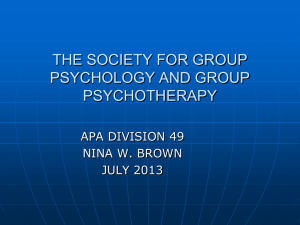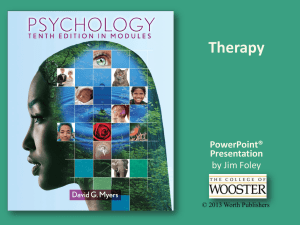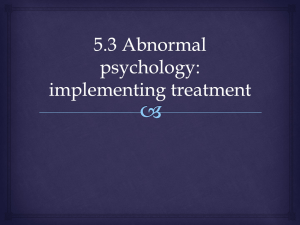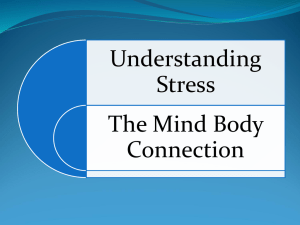Significant others list
advertisement
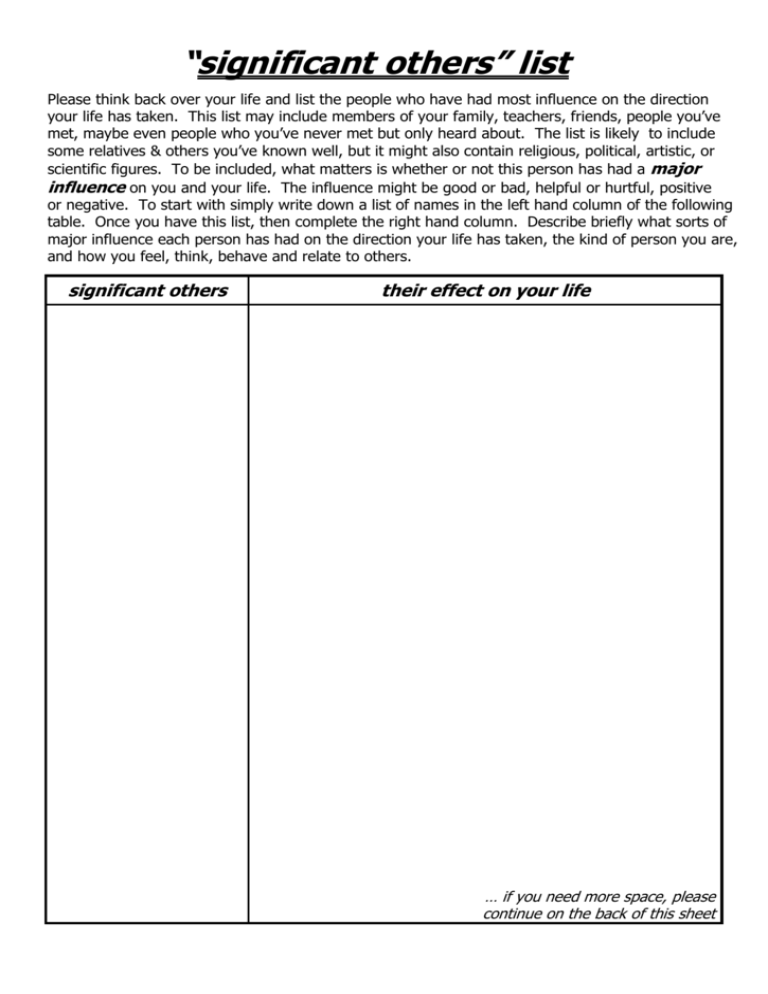
“significant others” list Please think back over your life and list the people who have had most influence on the direction your life has taken. This list may include members of your family, teachers, friends, people you’ve met, maybe even people who you’ve never met but only heard about. The list is likely to include some relatives & others you’ve known well, but it might also contain religious, political, artistic, or scientific figures. To be included, what matters is whether or not this person has had a major influence on you and your life. The influence might be good or bad, helpful or hurtful, positive or negative. To start with simply write down a list of names in the left hand column of the following table. Once you have this list, then complete the right hand column. Describe briefly what sorts of major influence each person has had on the direction your life has taken, the kind of person you are, and how you feel, think, behave and relate to others. significant others their effect on your life … if you need more space, please continue on the back of this sheet “significant others” list (cont.) If you need more space than is available on the first side of this sheet, please continue below significant others their effect on your life completing the “significant others” list McCullough completes the Significant Others List with his clients at their second psychotherapy session. I strongly suspect that he’s asking about people who the client has actually met, so I’ll need to be thoughtful as to whether the broader way I’ve phrased the question is helpful or confusing. McCullough first gets a list of significant others and then goes on to discuss each person on the list with his client. He asks about how the person has influenced the client’s life direction, the way they live, and the kind of person they are. He suggests that this “consequence” style of question is often hard for someone with chronic depression to get their heads round. He thinks that getting the client to think causally in this way may well be asking them to engage in problem solving at a developmentally higher level than they’re used to. In all likelihood, he comments “this will be the first time patients have identified historical precursors of their present behavior”. He highlights two common pitfalls that he finds therapists fall into when eliciting the Significant Others List. He states: Therapists should avoid verbalizing causal implications (i.e. drawing consequence conclusions) for patients after they have discussed significant others … Patients must be allowed to struggle with this probe “How did this person … influence the course of your life?” Therapists … must inhibit the impulse to do the causal work for the patient. The goal of treatment here is to guide patients to begin forming causal inferences between themselves and significant others. Therapists should avoid allowing patients to describe and free-associate about life events with significant others without requiring them to draw causal inferences between the behavior of significant others and their own behavior … the error … occurs when therapists allow patients to ramble on … describing “what happened” when they lived around particular persons. … what the therapist is looking for … are causal associations for the “If this … then that” format of the transference hypothesis e.g. “If I am around a woman, then I will be criticized” and so on. McCullough, J.P. Jr. Treatment of chronic depression: cognitive behavioral analysis system of psychotherapy. p.87- New York: Guilford Press, 2000. (Keller, McCullough et al. 2000) Keller, M. B., J. P. McCullough, et al. (2000). "A comparison of nefazodone, the cognitive behavioral-analysis system of psychotherapy, and their combination for the treatment of chronic depression." N Engl J Med 342(20): 1462-70. BACKGROUND: Patients with chronic forms of major depression are difficult to treat, and the relative efficacy of medications and psychotherapy is uncertain. METHODS: We randomly assigned 681 adults with a chronic non psychotic major depressive disorder to 12 weeks of outpatient treatment with nefazodone (maximal dose, 600 mg per day), the cognitive behavioral-analysis system of psychotherapy (16 to 20 sessions), or both. At base line, all patients had scores of at least 20 on the 24-item Hamilton Rating Scale for Depression (indicating clinically significant depression). Remission was defined as a score of 8 or less at weeks 10 and 12. For patients who did not have remission, a satisfactory response was defined as a reduction in the score by at least 50 percent from base line and a score of 15 or less. Raters were unaware of the patients' treatment assignments. RESULTS: Of the 681 patients, 662 attended at least one treatment session and were included in the analysis of response. The overall rate of response (both remission and satisfactory response) was 48 percent in both the nefazodone group and in the psychotherapy group, as compared with 73 percent in the combined-treatment group. (P<0.001 for both comparisons). Among the 519 subjects who completed the study, the rates of response were 55 percent in the nefazodone group and 52 percent in the psychotherapy group, as compared with 85 percent in the combined-treatment group (P<0.001 for both comparisons). The rates of withdrawal were similar in the three groups. Adverse events in the nefazodone group were consistent with the known side effects of the drug (e.g., headache, somnolence, dry mouth, nausea, and dizziness). CONCLUSIONS: Although about half of patients with chronic forms of major depression have a response to short-term treatment with either nefazodone or a cognitive behavioral-analysis system of psychotherapy, the combination of the two is significantly more efficacious than either treatment alone.




